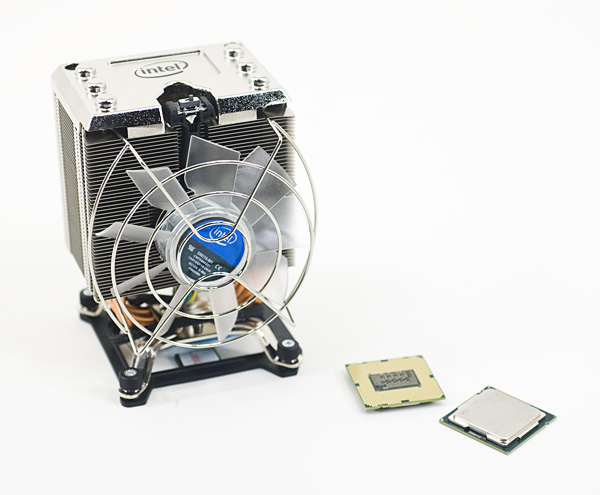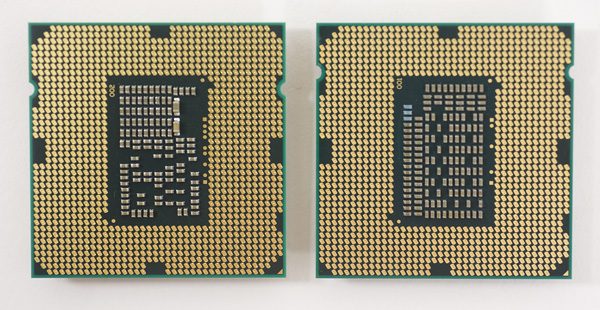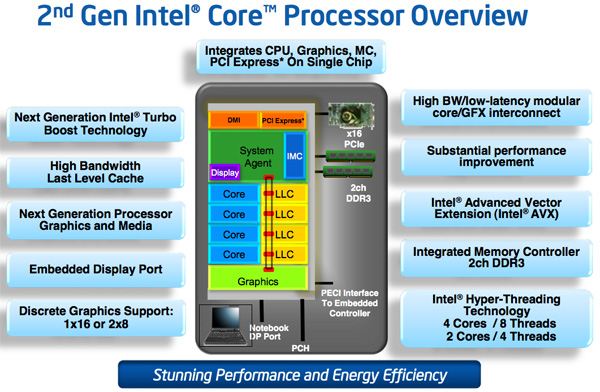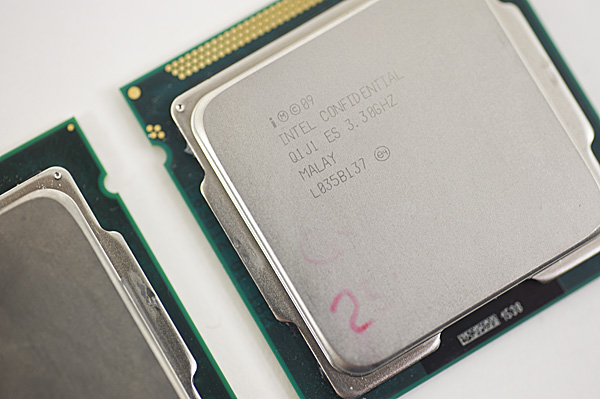The Sandy Bridge Review: Intel Core i7-2600K, i5-2500K and Core i3-2100 Tested
by Anand Lal Shimpi on January 3, 2011 12:01 AM ESTIntel never quite reached 4GHz with the Pentium 4. Despite being on a dedicated quest for gigahertz the company stopped short and the best we ever got was 3.8GHz. Within a year the clock (no pun intended) was reset and we were all running Core 2 Duos at under 3GHz. With each subsequent generation Intel inched those clock speeds higher, but preferred to gain performance through efficiency rather than frequency.
Today, Intel quietly finishes what it started nearly a decade ago. When running a single threaded application, the Core i7-2600K will power gate three of its four cores and turbo the fourth core as high as 3.8GHz. Even with two cores active, the 32nm chip can run them both up to 3.7GHz. The only thing keeping us from 4GHz is a lack of competition to be honest. Relying on single-click motherboard auto-overclocking alone, the 2600K is easily at 4.4GHz. For those of you who want more, 4.6-4.8GHz is within reason. All on air, without any exotic cooling.
Unlike Lynnfield, Sandy Bridge isn’t just about turbo (although Sandy Bridge’s turbo modes are quite awesome). Architecturally it’s the biggest change we’ve seen since Conroe, although looking at a high level block diagram you wouldn’t be able to tell. Architecture width hasn’t changed, but internally SNB features a complete redesign of the Out of Order execution engine, a more efficient front end (courtesy of the decoded µop cache) and a very high bandwidth ring bus. The L3 cache is also lower and the memory controller is much faster. I’ve gone through the architectural improvements in detail here. The end result is better performance all around. For the same money as you would’ve spent last year, you can expect anywhere from 10-50% more performance in existing applications and games from Sandy Bridge.
I mentioned Lynnfield because the performance mainstream quad-core segment hasn’t seen an update from Intel since its introduction in 2009. Sandy Bridge is here to fix that. The architecture will be available, at least initially, in both dual and quad-core flavors for mobile and desktop (our full look at mobile Sandy Bridge is here). By the end of the year we’ll have a six core version as well for the high-end desktop market, not to mention countless Xeon branded SKUs for servers.
The quad-core desktop Sandy Bridge die clocks in at 995 million transistors. We’ll have to wait for Ivy Bridge to break a billion in the mainstream. Encompassed within that transistor count are 114 million transistors dedicated to what Intel now calls Processor Graphics. Internally it’s referred to as the Gen 6.0 Processor Graphics Controller or GT for short. This is a DX10 graphics core that shares little in common with its predecessor. Like the SNB CPU architecture, the GT core architecture has been revamped and optimized to increase IPC. As we mentioned in our Sandy Bridge Preview article, Intel’s new integrated graphics is enough to make $40-$50 discrete GPUs redundant. For the first time since the i740, Intel is taking 3D graphics performance seriously.
| CPU Specification Comparison | ||||||||
| CPU | Manufacturing Process | Cores | Transistor Count | Die Size | ||||
| AMD Thuban 6C | 45nm | 6 | 904M | 346mm2 | ||||
| AMD Deneb 4C | 45nm | 4 | 758M | 258mm2 | ||||
| Intel Gulftown 6C | 32nm | 6 | 1.17B | 240mm2 | ||||
| Intel Nehalem/Bloomfield 4C | 45nm | 4 | 731M | 263mm2 | ||||
| Intel Sandy Bridge 4C | 32nm | 4 | 995M | 216mm2 | ||||
| Intel Lynnfield 4C | 45nm | 4 | 774M | 296mm2 | ||||
| Intel Clarkdale 2C | 32nm | 2 | 384M | 81mm2 | ||||
| Intel Sandy Bridge 2C (GT1) | 32nm | 2 | 504M | 131mm2 | ||||
| Intel Sandy Bridge 2C (GT2) | 32nm | 2 | 624M | 149mm2 | ||||
It’s not all about hardware either. Game testing and driver validation actually has real money behind it at Intel. We’ll see how this progresses over time, but graphics at Intel today very different than it has ever been.
Despite the heavy spending on an on-die GPU, the focus of Sandy Bridge is still improving CPU performance: each core requires 55 million transistors. A complete quad-core Sandy Bridge die measures 216mm2, only 2mm2 larger than the old Core 2 Quad 9000 series (but much, much faster).
As a concession to advancements in GPU computing rather than build SNB’s GPU into a general purpose compute monster Intel outfitted the chip with a small amount of fixed function hardware to enable hardware video transcoding. The marketing folks at Intel call this Quick Sync technology. And for the first time I’ll say that the marketing name doesn’t do the technology justice: Quick Sync puts all previous attempts at GPU accelerated video transcoding to shame. It’s that fast.
There’s also the overclocking controversy. Sandy Bridge is all about integration and thus the clock generator has been moved off of the motherboard and on to the chipset, where its frequency is almost completely locked. BCLK overclocking is dead. Thankfully for some of the chips we care about, Intel will offer fully unlocked versions for the enthusiast community. And these are likely the ones you’ll want to buy. Here’s a preview of what’s to come:
The lower end chips are fully locked. We had difficulty recommending most of the Clarkdale lineup and I wouldn’t be surprised if we have that same problem going forward at the very low-end of the SNB family. AMD will be free to compete for marketshare down there just as it is today.
With the CPU comes a new platform as well. In order to maintain its healthy profit margins Intel breaks backwards compatibility (and thus avoids validation) with existing LGA-1156 motherboards, Sandy Bridge requires a new LGA-1155 motherboard equipped with a 6-series chipset. You can re-use your old heatsinks however.

Clarkdale (left) vs. Sandy Bridge (right)
The new chipset brings 6Gbps SATA support (2 ports) but still no native USB 3.0. That’ll be a 2012 thing it seems.













283 Comments
View All Comments
Kevin G - Monday, January 3, 2011 - link
There is the Z67 chipset which will allow both overclocking and integrated video. However, this chipset won't arrive until Q2.Tanel - Monday, January 3, 2011 - link
Well, yes, but one wonders who came up with this scheme in the first place. Q2 could be half a year from now.teohhanhui - Monday, January 3, 2011 - link
I've been thinking the same thing while reading this article... It makes no sense at all. Bad move, Intel.micksh - Monday, January 3, 2011 - link
Exactly my thoughts. No Quick Sync for enthusiasts right now - that's a disappointment. I think it should be stated more clearly in review.Another disappointment - missing 23.976 fps video playback.
has407 - Monday, January 3, 2011 - link
Yeah, OK, lack of support for VT-d ostensibly sucks on the K parts, but as previously posted, I think there may be good reasons for it. But lets look at it objectively...1. Do you have an IO-intensive VM workload that requires VT-d?
2. Is the inefficiency/time incurred by the lack of VT-d support egregious?
3. Does your hypervisor, BIOS and chipset support VT-d?
IF you answered "NO" or "I don't know" to any of those questions, THEN what does it matter? ELSE IF you answered "YES" to all of those questions, THEN IMHO SB isn't the solution you're looking for. END IF. Simple as that.
So because you--who want that feature and the ability to OC--which is likely 0.001% of the customers who are too cheap to spend the $300-400 for a real solution--the vendor should spend 10-100X to support that capability--which will thus *significantly* increase the cost to the other 99.999% of the customers. And that makes sense how and to whom (other than you and the other 0.0001%)?
IMHO you demand a solution at no extra cost to a potential problem you do not have (or have not articulated); or you demand a solution at no extra cost to a problem you have and for which the market is not yet prepared to offer at a cost you find acceptable (regardless of vendor).
Tanel - Tuesday, January 4, 2011 - link
General best practice is not to feed the trolls - but in this case your arguments are so weak I will go ahead anyway.First off, I like how you - without having any insight in my usage profile - question my need for VT-d and choose to call it "lets look at it objectively".
VT-d is excellent when...
a) developing hardware drivers and trying to validate functionality on different platforms.
b) fooling around with GPU passthrough, something I did indeed hope to deploy with SB.
So yes, I am in need of VT-d - "Simple as that".
Secondly, _all_ the figures you've presented are pulled out of your ass. I'll be honest, I had a hard time following your argument as much of what you said makes no sense.
So I should spend more money to get an equivalent retail SKU? Well then Sir, please go ahead and show me where I can get a retail SB SKU clocked at >4.4GHz. Not only that, you're in essence implying that that people only overclock because they're cheap. In case you've missed it it's the enthusiasts buying high-end components that enable much of the next-gen research and development.
The rest - especially the part with 10-100X cost implication for vendors - is the biggest pile of manure I've come across on Anandtech. What we're seeing here is a vendor stripping off already existing functionality from a cheaper unit while at the same time asking for a premium price.
If I were to make a car analogy, it'd be the same as if Ferrari sold the 458 in two versions. One with a standard engine, and one with a more powerful engine that lacks headlights. By your reasoning - as my usage profile is in need of headlights - I'd just have to settle with the tame version. Not only would Ferrari lose the added money they'd get from selling a premium version, they would lose a sell as I'd rather be waiting until they present a version that fits my needs. I sure hope you're not running a business.
There is no other way to put it, Intel fucked up. I'd be jumping on the SB-bandwagon right now if it wasn't for this. Instead, I'll be waiting.
has407 - Tuesday, January 4, 2011 - link
Apologies, didn't mean to come across as a troll or in-your-face idjit (although I admittedly did--lesson learned ). Everyone has different requirements/demands, and I presumed and assumed too much when I should not have, and should have been more measured in my response.You're entirely correct to call me on the fact that I know little or nothing about your requirements. Mea culpa. That said, I think SB is not for the likes of you (or I). While it is a "mainstream" part, it has a few too many warts..
Does that mean Intel "fucked up"? IMHO no--they made a conscious decision to serve a specific market and not serve others. And no, that "10-100X" is not hot air but based on costing from several large scale deployments. Frickin amazing what a few outliers can do to your cost/budget.
Akv - Monday, January 3, 2011 - link
I didn't have time to read all reviews, and furthermore I am not sure I will be able to express what I mean with the right nuances, since English is not my first language.For the moment I am a bit disappointed. To account for my relative coldness, it is important to explain where I start from :
1) For gaming, I already have more than I need with a quad core 775 and a recent 6x ati graphic card.
2) For office work, I already have more than I need with an i3 clarkdale.
Therefore since I am already equipped, I am of course much colder than those who need to buy a new rig just now.
Also, the joy of trying on a new processor must be tempered with several considerations :
1) With Sandy Bridge, you have to add a new mobo in the price of the processor. That makes it much more expansive. And you are not even sure that 1155 will be kept for Ivy Bridge. That is annoying.
2) There are always other valuable things that you can buy for a rig, apart from the sheer processor horsepower : more storage, better monitor...
3) The power improvement that comes with Sandy Bridge with what I call a normal improvement for a new generation of processors. It is certainly not a quantum leap in the nature of processors.
Now, there are two things I really dislike :
1) If you want to use P67 with a graphic card, you still have that piece of hardware, the IGP, that you actually bought and that you cannot use. That seems to me extremely unelegant compared to the 775 generation of processors. It is not an elegant architecture.
2) If you want to use H67 and the Intel IGP for office work and movies, the improvement compared to clarkdale is not sufficient to justify the buying of a new processor and a new mobo. With H67 you will be able to do office work fluently and watch quasi perfectly, with clarkdale you already could.
The one thing that I like is the improvement in consumption. Otherwise it all seems to me a bit awkward.
sviola - Monday, January 3, 2011 - link
Well, the IGP non being removable is like having on-board sound, but also having a dedicated soundcard. Not much of a deal, since you can't buy a motherboard withou integrated sound nowadays...Shadowmaster625 - Monday, January 3, 2011 - link
You say you want Intel to provide a $70 gpu. Well, here's a math problem for you: If the gpu on a 2600K is about 22% of the die, and the die costs $317 retail, then how much are you paying for the gpu? If you guessed $70, you win! Congrats, you now payed $70 for a crap gpu. The question is.... why? There is no tock here... only ridiculously high margins for Intel.